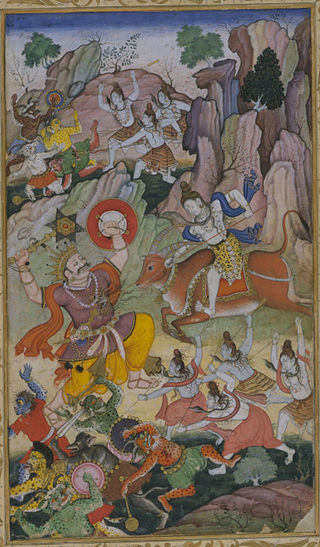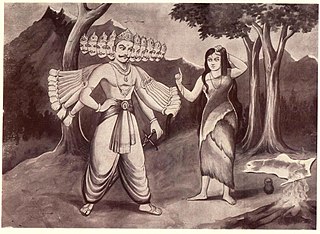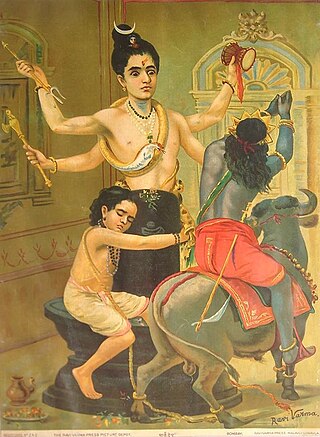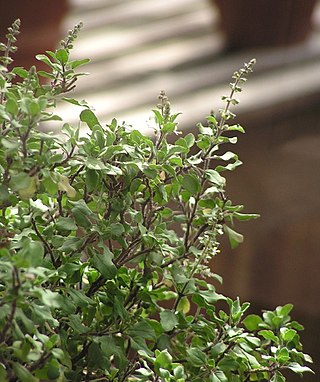
Virabhadra, also rendered Veerabhadra, Veerabathira, and Veerabathiran, is a fierce form of the Hindu god Shiva. He is created by the wrath of Shiva, when the deity hurls a lock of his matted hair upon the ground, upon hearing of the self-immolation of his consort, Sati, at the Daksha yajna.

In Hindu literature, Andhaka refers to a malevolent asura, whose pride is vanquished by Shiva and Parvati.

Rati is the Hindu goddess of love, carnal desire, lust, passion, and sexual pleasure. Usually described as the daughter of Prajapati Daksha, Rati is the female counterpart, the chief consort and the assistant of Kama (Kamadeva), the god of love. A constant companion of Kama, she is often depicted with him in legend and temple sculpture. She also enjoys worship along with Kama.

Rukmini is a Hindu goddess and the first queen of Krishna in Dvaraka. In Vaishnava tradition, she is described as Krishna's principal queen in Dvaraka, as well as the chief of his wives. She is an incarnation of the goddess of prosperity, Lakshmi. The goddess is regarded to be the chief or principal consort of Krishna in various pieces of literature and is venerated primarily in Warkari and Haridasa tradition, and additionally in Sri Vaishnavism where Lakshmi-Narayana are revered and worshipped.

Subhadra is a figure in Hindu mythology, known for being the younger sister of gods Krishna and Balarama. According to Hindu scriptures, she was a princess from the Yadava clan, who married Arjuna—one of the Pandava brothers—and had a son named Abhimanyu.

In Hindu scriptures, Durvasa, also known as Durvasas, is a legendary rishi (sage). He is the son of Anasuya and Atri. According to some Puranas, Durvasa is a partial avatar of Shiva, known for his short temper. Wherever he goes, he is received with great reverence by humans and devas alike.

Kamakhya, a mother goddess, is a Shakta Tantric deity; considered to be the embodiment of Kama (desire), she is regarded as the goddess of desire. Her abode–Kamakhya Temple is located in the Kamarupa region of Assam, India. Originally a Kirata goddess, Kamakhya remained outside Brahmanical influence until at least 7th century CE. Residing on Nilachal hills across the banks of the Brahmaputra river, west of Guwahati in the 10th/11th century Temple rebuilt in 1565 CE, she is worshiped in a non-iconic and un-anthropomorphic form of stone shaped like yoni fed by a perennial stream. The temple is primary amongst the 51 Shakti Pithas, and is one of the most important Shakta temples.

Sati, also known as Dakshayani, is the Hindu goddess of marital felicity and longevity, and is worshipped as an aspect of the mother goddess Shakti. Sati was the first wife of Shiva, the other being Parvati, who was Sati's reincarnation after her death.

Vedavati is the previous birth of the goddess Sita in Hindu mythology. She is an avatar of the goddess of prosperity, Lakshmi.

Bana, also referred to as Banasura, is an asura king in Hindu mythology, ruling from the city of Śoṇitapura. He is described to be the son of Mahabali. His tale of battling Krishna is described in the Bhagavata Purana.

Markandeya is a rishi (sage) featured in Hindu literature. He is the son of the sage Mrikanda and his wife, Manasvini. The Markandeya Purana, attributed to the sage, comprises a dialogue between Markandeya and a sage called Jaimini. A number of chapters in the Bhagavata Purana are dedicated to his conversations and prayers. He is also mentioned in the Mahabharata. Markandeya is venerated within all mainstream Hindu traditions.

Aniruddhatransl. 'unconquerable' is a character in Hindu mythology, the son of Pradyumna and Rukmavati, and the grandson of Krishna and Rukmini. He is said to have been very much like his grandfather, to the extent that he is considered by some to be a Jana avatar, an avatar of Vishnu. He is a member of the chatur-vyuha, the four Vrishni heroes.

Annapurna, Annapurneshwari, Annada or Annapoorna is a manifestation of Parvati and is known as the Hindu goddess of food and nourishment. Worship and offering of food are highly praised in Hinduism, and therefore, the goddess Annapurna is regarded as a popular deity. She is a manifestation of the goddess Parvati, the wife of Shiva, and is eulogized in the Annada Mangal, a narrative poem in Bengali by Bharatchandra Ray. The Annapurna Sahasranam is dedicated to the goddess and praises her one thousand names, while the Annapurna Shatanama Stotram is dedicated to her 108 names.

Nageshwara Jyotirlinga is a temple and pilgrimage site devoted to Shiva and houses one of the twelve Jyotirlingas. It is located in Aundha Nagnath, Maharashtra.
Tarakasura is a powerful asura in Hindu mythology. He is the son of the asura Vajranga and his wife Vajrangi. Taraka had three sons: Tarakaksha, Vidyunmali, and Kamalaksha, who were known as the Tripurasura. He is slain by Kartikeya.

Tumburu is the foremost among the gandharvas, the celestial musicians of Hindu mythology. Accounts depict him performing in the courts of the deities Kubera and Indra, and as singing the praises of Vishnu. He is said to lead the gandharvas in their singing.

Tulasi, or Vrinda is a sacred plant in Hindu tradition. Hindus regard it as an earthly manifestation of the goddess Tulasi; she is regarded as the avatar of Lakshmi, and thus the consort of the god Vishnu. In another iteration, as Vrinda, she is married to Jalandhara. The offering of its leaves is recommended in ritualistic worship of Vishnu and his avatars, like Krishna and Vithoba.

Jambavati is chronologically the second Ashtabharya of the Hindu god Krishna. She is the only daughter of the bear-king Jambavan. Krishna marries her when he defeats her father, Jambavan, in his quest to retrieve the stolen Syamantaka jewel.
The Mahabhagavata Purana, also called the Devi Purana, is an upapurana traditionally attributed to the sage Vyasa. Written between the tenth and eleventh centuries CE in Bengal, the work belongs to the Shakta tradition. It primarily describes the legends of the supreme goddess of Hinduism, Mahadevi, and her manifestation as the goddesses Sati, Parvati, Kali, and Ganga. The work is regarded to have been strongly influenced by the Tantra tradition, including descriptions of the Tantric forms of goddess-worship such as the mahavidyas, and integrating them with the Vedanta school of thought.

Usha is a character in Hindu mythology. She is the daughter of the asura king Banasura and the wife of Aniruddha, the grandson of Krishna. Her story of falling in love with Aniruddha and wedding him is described in the Bhagavata Purana.



















